Doménikos Theotokópoulos, known over the world by his byname El Greco, was an artist of Greek origin who was active in Spain and was among the leading figures of the Spanish Renaissance of the 15th and 16th centuries. El Greco excelled as a painter of religious subjects but was also equally adept in portraiture and landscapes. His art is considered a precursor of both Expressionism and Cubism; and is so individualistic that art historians struggle to place him in any conventional school. Know about the art of El Greco by studying his 10 most famous paintings.
#10 The Holy Trinity

| Spanish Title: | La Trinidad |
| Location: | Museo del Prado, Madrid, Spain |
| Year: | 1579 |
This painting was part of the first major commission of El Greco which consisted of a group of works created for the church Santo Domingo el Antiguo in Toledo. It showed early glimpses of El Greco’s pictorial genius marked by continuity and brilliant use of color. The Holy Trinity brought El Greco great fame in Toledo, is counted among his masterworks and was revered by next generation of artists including famous French painter Édouard Manet.
#9 The Miracle of Christ Healing the Blind
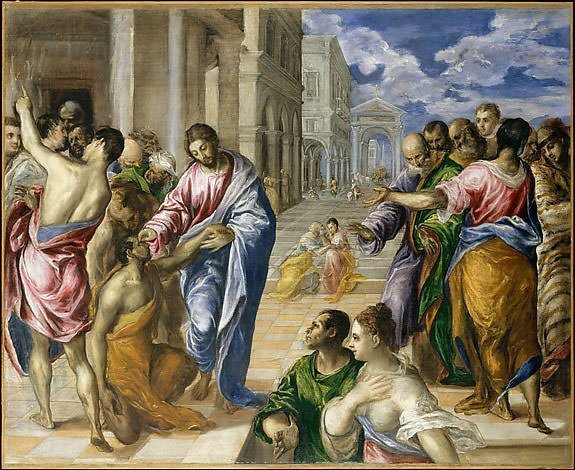
| Spanish Title: | La curación del ciego |
| Location: | The MET, New York City, U.S. |
| Year: | 1570 |
El Greco created this artwork in his early career before moving to Spain. Painted in the Venetian Renaissance style, this masterpiece of dramatic storytelling illustrates the Gospel account of Christ healing a blind man by anointing his eyes. The subject was popular at the time as the healing of blindness was symbolic of revelation of the true faith. Christ Healing the Blind is considered the finest work of El Greco’s early period.
#8 The Adoration of the Shepherds
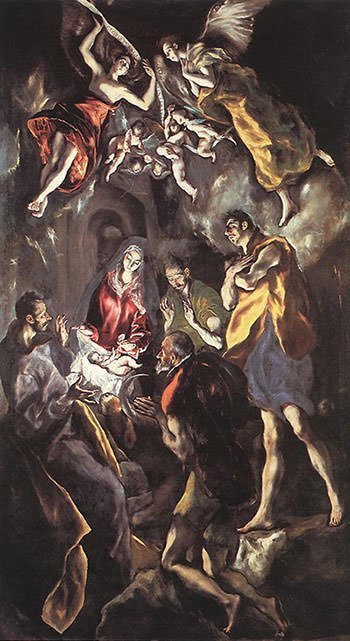
| Spanish Title: | La adoración de los pastores |
| Location: | Museo del Prado, Madrid, Spain |
| Year: | 1614 |
This painting depicts the shepherd and angels celebrating the miracle of the newly born Jesus. El Greco has brilliantly used strange poses, rhythmic dance like motions and dissonant colors to create a sense of wonder and ecstasy for the viewer. The painting is also noted for extreme distortion of body which marked the last works of El Greco. El Greco’s assistant said that his teacher was working on this painting till his death in April 1614.
#7 Assumption of the Virgin
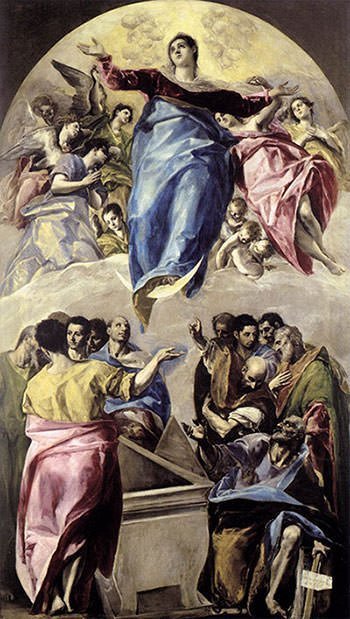
| Spanish Title: | Asunción de la Virgen |
| Location: | Art Institute of Chicago, U.S. |
| Year: | 1579 |
This enormous painting was part of the first major commission of El Greco. Painted for the high altar of the church of Santo Domingo el Antiguo in Toledo, it established his reputation in the area. Though painted in Venetian technique, El Greco used the intensity of colors and manipulation of contrasts that were to become a hallmark of his artworks. Assumption of the Virgin marked a new period in the artist’s life, revealing the full extent of his genius.
#6 Laocoön
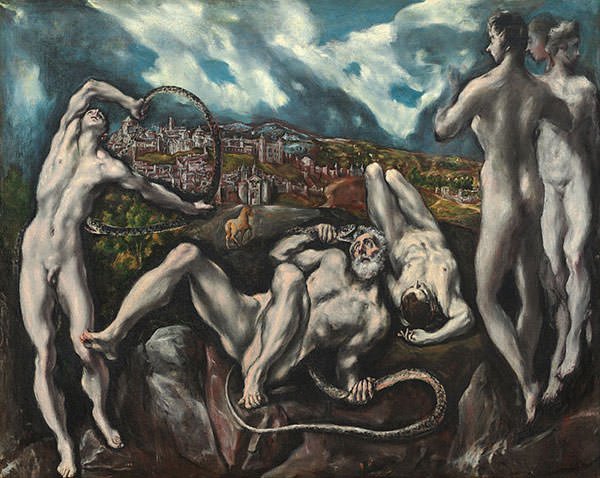
| Spanish Title: | Laocoonte |
| Location: | National Gallery of Art, Washington, D.C., U.S. |
| Year: | 1614 |
This painting depicts the mythical deaths of Laocoön, a Trojan priest of Poseidon, and his two sons Antiphantes and Thymbraeus. According to the myth, Laocoön warned his countrymen about the Trojan horse; and he and his sons were strangled by giant sea serpents sent by the Gods as punishment. Laocoön and Fifth Seal are the paintings of El Greco which have had the deepest impact on modern painting. The former is essential to Expressionism and the latter to Cubism.
#5 The Nobleman with his Hand on his Chest

| Spanish Title: | El caballero de la mano en el pecho |
| Location: | Museo del Prado, Madrid, Spain |
| Year: | 1580 |
Though more known for religious paintings, El Greco also excelled as a portraitist. He is renowned for not only elegantly recording the features of his subjects but also conveying their character. This portrait of a knight with his hand on his breast and leaning slightly to the left on his sword is part of his series of portraits of unknown gentlemen. It is perhaps his most famous work in portraiture.
#4 The Disrobing of Christ
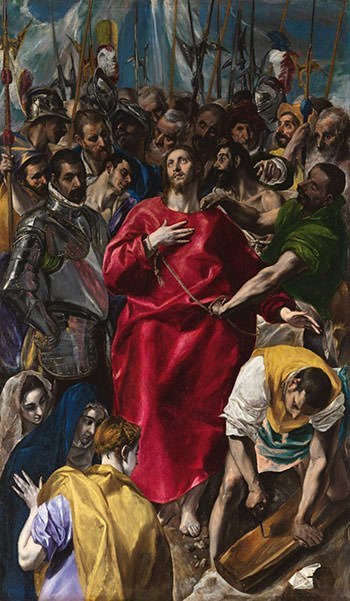
| Spanish Title: | El expolio |
| Location: | Sacristy of Toledo Cathedral, Toledo, Spain |
| Year: | 1579 |
Regarded a masterpiece of extraordinary originality, this painting depicts the disrobing of Christ before he was crucified. Here El Greco has used a method of space elimination used in Mannerism and the late Byzantine way of superposition of heads row upon row to suggest a crowd. The painting is especially noted for the powerful effect created by El Greco through forceful use of colors and for the masterful depiction of the oppression of Christ by his cruel tormentors.
#3 Opening of the Fifth Seal
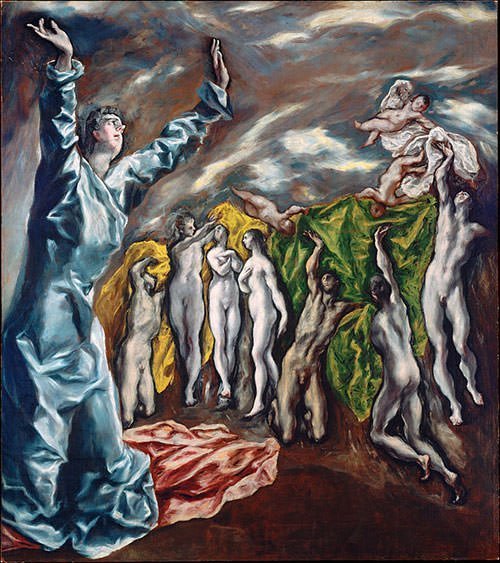
| Spanish Title: | Visión del Apocalipsis |
| Location: | The MET, New York City, U.S. |
| Year: | 1614 |
Also known as The Vision of Saint John, this painting is the most famous artwork of El Greco’s later years. It depicts a passage from the Book of Revelation of the New Testament where the fifth seal is being opened at the end of time and the souls of the martyrs are crying out to God for deliverance. Many art critics believe that Fifth Seal was an influence on Pablo Picasso’s Les Demoiselles d’Avignon, often considered the first cubist painting, and this has led to great debate adding to the fame of this masterpiece.
#2 View of Toledo

| Spanish Title: | Vista de Toledo |
| Location: | The MET, New York City, U.S. |
| Year: | 1600 |
Landscape paintings were rare in Spanish art of the time and this painting is one of only three surviving landscapes by El Greco. Among El Greco’s most cherished masterpieces, View of Toledo is renowned for its enigmatic symbolism and for the majestically executed contrast between the dark skies above and the glowing green below. Along with Van Gogh’s The Starry Night, it remains one of the most famous depictions of the sky in Western art.
#1 The Burial of the Count of Orgaz
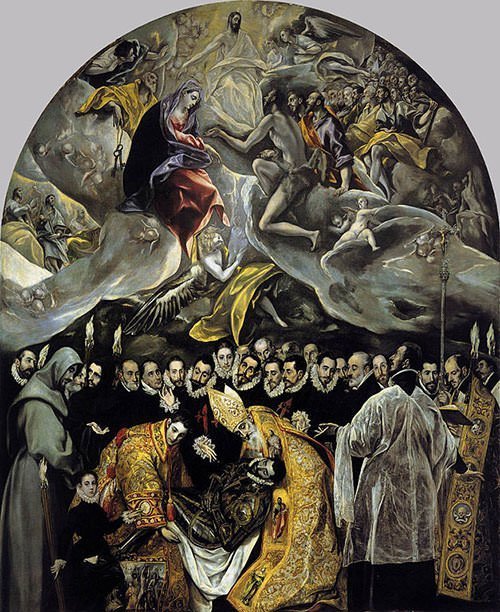
| Spanish Title: | El entierro del conde de Orgaz |
| Location: | Church of Santo Tomé, Toledo, Spain |
| Year: | 1588 |
This painting was commissioned to El Greco in 1586 by the parish priest of Santo Tomé in Toledo, Spain. It illustrates a popular local legend by which Saints Augustine and Stephen descended from the heavens to assist in the burial of Don Gonzalo Ruíz, a native of Toledo known for philanthropy and piety; and who was posthumously known as Count of Orgaz. The lower section of the painting depicts the miraculous burial while the above shows the spiritual world waiting to receive the pious man into heaven. As the artwork is a prime example of Mannerism, depicts a visionary experience and contains an impressive array of portraits, it is seen by art critics as the coming together of all extraordinary attributes of the genius’s art. It is not only the most famous painting by El Greco but also universally regarded as his greatest masterpiece.

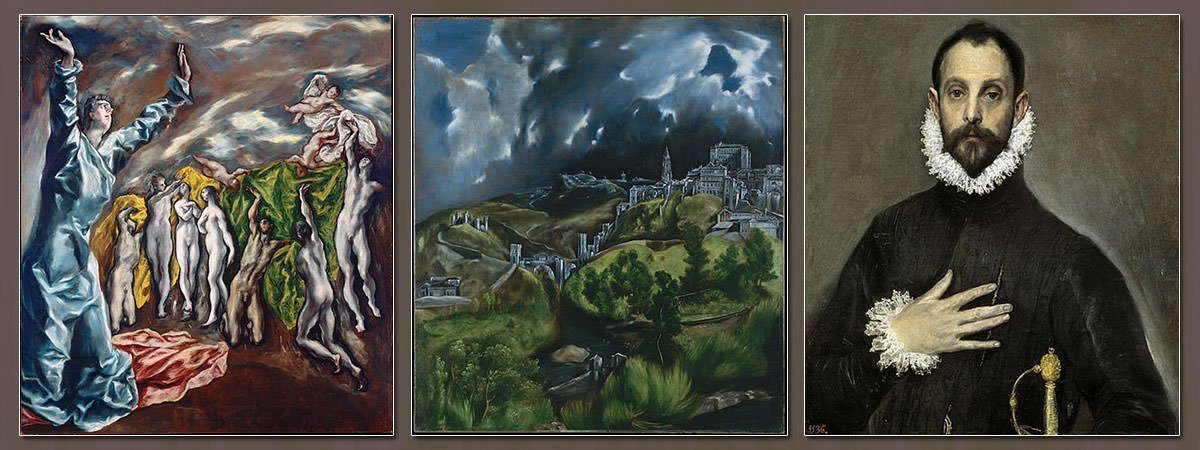
Hello, I have a painting of the nobleman with hand on his chest by EL GRECO…im trying to find out if I can sell it and if so for how much cash? I’m very interested in learning more about this wonderful piece of history.
PLEASE HELP
THANK YOU AND GOD SPEED
I am sure you can sell it for a great price. However, unfortunately, I can’t guide you regarding this. I am still publishing your comment if it might prove helpful.
Hello, Good blog. I can’t wait to read a lot more of your site.